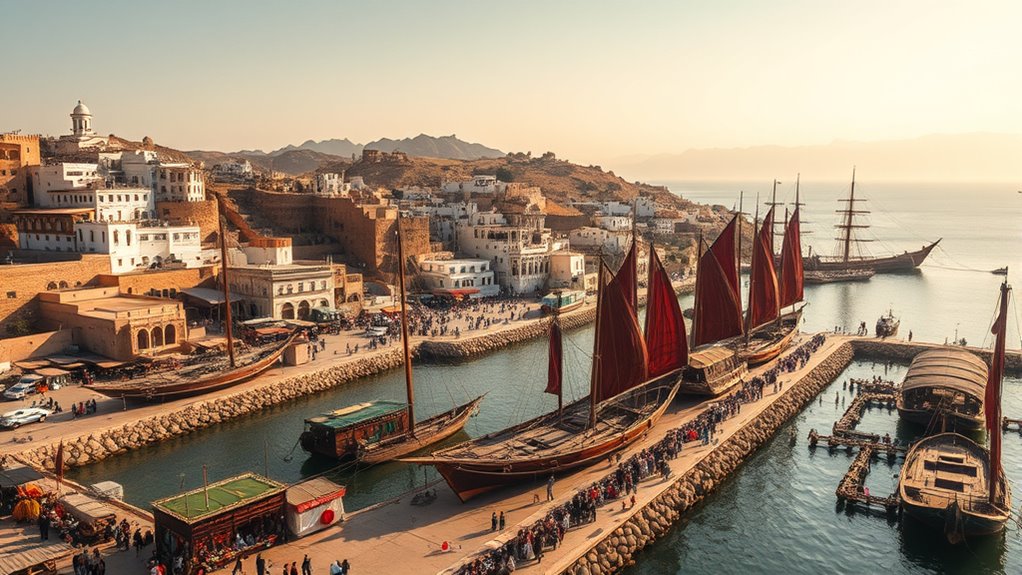The Port of Mocha played a vital role in connecting Yemen to global trade networks, especially in the spice trade. As a key hub along the Indian Ocean, it facilitated the exchange of spices, textiles, and cultural influences between Asia, Africa, and Europe. Its strategic location and maritime innovations made it a bustling center of commerce and cultural exchange. To discover more about how Mocha shaped early global trade, keep exploring its rich history.
Key Takeaways
- The Port of Mocha was a vital hub in early global trade, connecting Yemen to Indian Ocean routes and beyond.
- It played a central role in the spice trade, facilitating the exchange of cinnamon, pepper, and other valuable commodities.
- Maritime archaeology reveals shipwrecks and trade ware that illustrate Mocha’s importance as a cultural and commercial crossroads.
- Mocha’s strategic location enabled extensive cultural exchanges, influencing art, cuisine, and technology across connected regions.
- Technological innovations in shipbuilding and navigation supported long-distance trade, cementing Mocha’s role in early global commerce.

Nestled along the coast of modern-day Yemen, the Port of Mocha became a pivotal hub in early global trade networks. As you explore its history, you’ll find that maritime archaeology reveals how this port served as a essential link connecting traders across the Indian Ocean and beyond. The port’s strategic location allowed it to dominate the spice trade routes, which were indispensable for the exchange of valuable spices, textiles, and other goods. These routes, stretching from Asia to Africa and the Middle East, made Mocha a bustling center where merchants and ships converged, exchanging commodities and ideas.
Through maritime archaeology, you can uncover remnants of ancient ships, cargo holds, and trade ware, all telling stories of the bustling activity that once thrived here. These discoveries help piece together the complex network of trade that propelled the port into prominence. Mocha’s significance wasn’t solely due to its geographic position; it also became a melting pot of cultures, languages, and traditions, thanks to the diverse traders passing through. The port facilitated not only commerce but also cultural exchange, which influenced art, cuisine, and technology across regions.
Maritime archaeology uncovers ships and trade ware revealing Mocha’s cultural and commercial crossroads.
The spice trade routes that crisscrossed the Indian Ocean played an essential role in shaping the economic and political landscape of the region. As you examine the history of Mocha, you’ll see how it acted as a gateway for spices like cinnamon, pepper, and cardamom, which were in high demand across Europe, Asia, and Africa. Traders from different parts of the world came here to buy, sell, and transfer spices, often using ships that carried these fragrant commodities over long distances. The port’s warehouses and marketplaces buzzed with activity, reflecting its importance as a trading hub.
Your understanding of Mocha’s role in early global trade deepens when you consider the archaeological evidence of the maritime routes that connected it to distant lands. The port’s prominence declined with the rise of other trade centers, but its legacy as a key node in the spice trade routes endures. By studying maritime archaeology, you gain insights into the technological innovations and navigational skills that made these long voyages possible. Overall, the Port of Mocha stands as a tribute to how strategic location, maritime expertise, and the pursuit of valuable commodities like spices shaped the course of world history.
Additionally, advancements in maritime navigation skills and shipbuilding technology facilitated these extensive voyages, enabling traders to reach distant shores with greater safety and efficiency.
Frequently Asked Questions
How Did Mocha’s Trade Influence Global Coffee Culture?
Mocha’s trade shaped global coffee culture by establishing key trade routes that spread coffee from Yemen to the wider world. You see, these routes facilitated cultural exchanges, blending Yemeni traditions with new tastes and brewing methods. As coffee traveled along these paths, it gained popularity, inspiring cafes and rituals worldwide. Mocha’s role in early trade made coffee more than a drink; it became a cultural phenomenon connecting diverse societies.
What Specific Goods, Besides Coffee, Were Traded Through Mocha?
You’ll find that, besides coffee, Mocha traded in silk textiles, spices, and incense. These goods flowed through the port, connecting Yemen to distant markets. Silk textiles from Asia, aromatic spices from India, and fragrant incense from the Middle East all passed through Mocha’s bustling docks. This diverse trade network helped shape global commerce, making Mocha a key hub for luxury goods and cultural exchange during early trade centuries.
How Did Mocha’s Geographic Location Affect Its Trade Routes?
Imagine standing at Mocha’s bustling port, where maritime navigation routes converge like a vibrant crossroads. Its strategic location along the Red Sea meant ships from Africa, Asia, and Europe easily accessed essential trade routes. The port’s infrastructure, including sturdy docks and warehouses, supported diverse goods like spices, textiles, and ivory. This geographic position made Mocha a pivotal hub, connecting distant worlds and fueling early international trade.
Were There Any Major Conflicts That Impacted Mocha’s Trading History?
You should know that pirate attacks and Ottoman conflicts markedly impacted Mocha’s trading history. Pirate attacks threatened ships and disrupted trade routes, making merchants wary. Ottoman conflicts in the region also led to military confrontations that affected port security and trade flow. These conflicts caused periods of instability, forcing traders to adapt or shift their routes, ultimately shaping Mocha’s role in early global trade networks.
How Did the Decline of Mocha’s Port Affect Regional Economies?
Imagine you’re witnessing a maritime decline that reshapes regional trade. As Mocha’s port declines, your local economies suffer, shifting economic power away from Yemen. This economic shift causes decreased trade, job losses, and reduced prosperity for coastal communities. The port’s decline leads to a ripple effect, weakening regional connections and prompting traders to seek new routes elsewhere, ultimately transforming the economic landscape and diminishing Yemen’s role in global commerce.
Conclusion
You now see how the Port of Mocha helped shape global trade, connecting Yemen to distant lands. Its history shows that “a journey of a thousand miles begins with a single step,” reminding us that small beginnings can lead to great voyages. By understanding Mocha’s role, you recognize how crucial early trade routes were in weaving the world closer together. Keep in mind, every great story starts with a single step—just like Mocha’s legacy.








